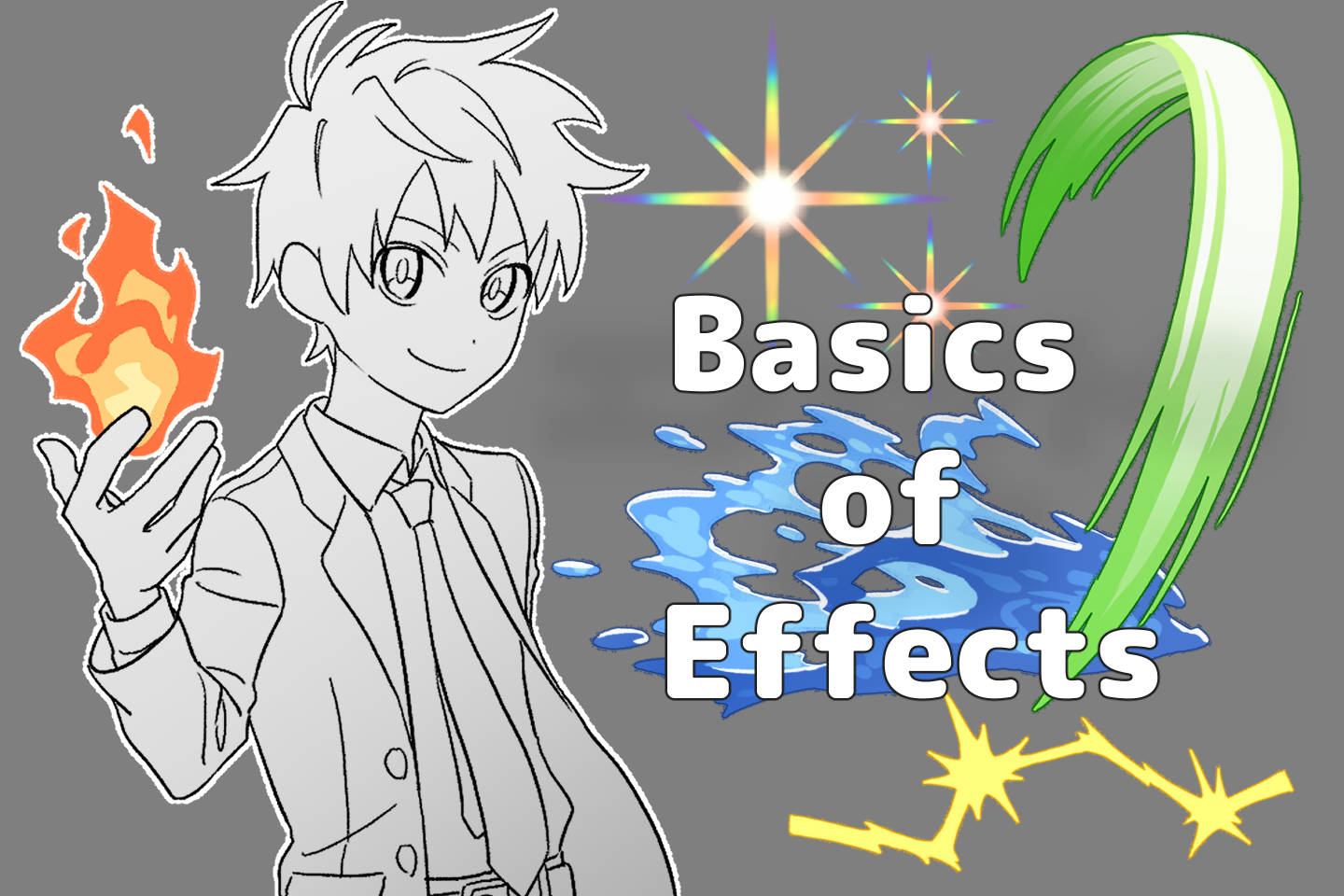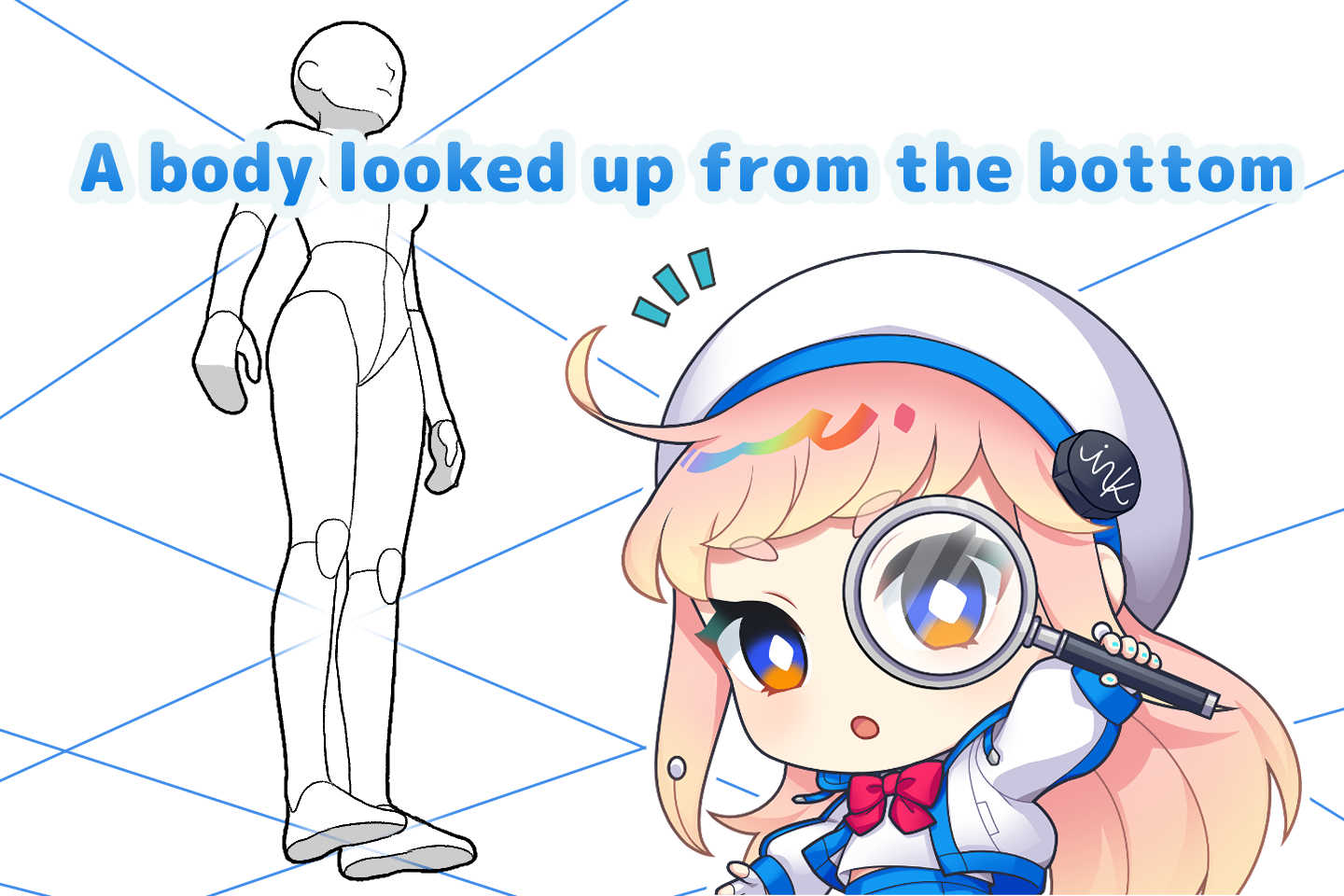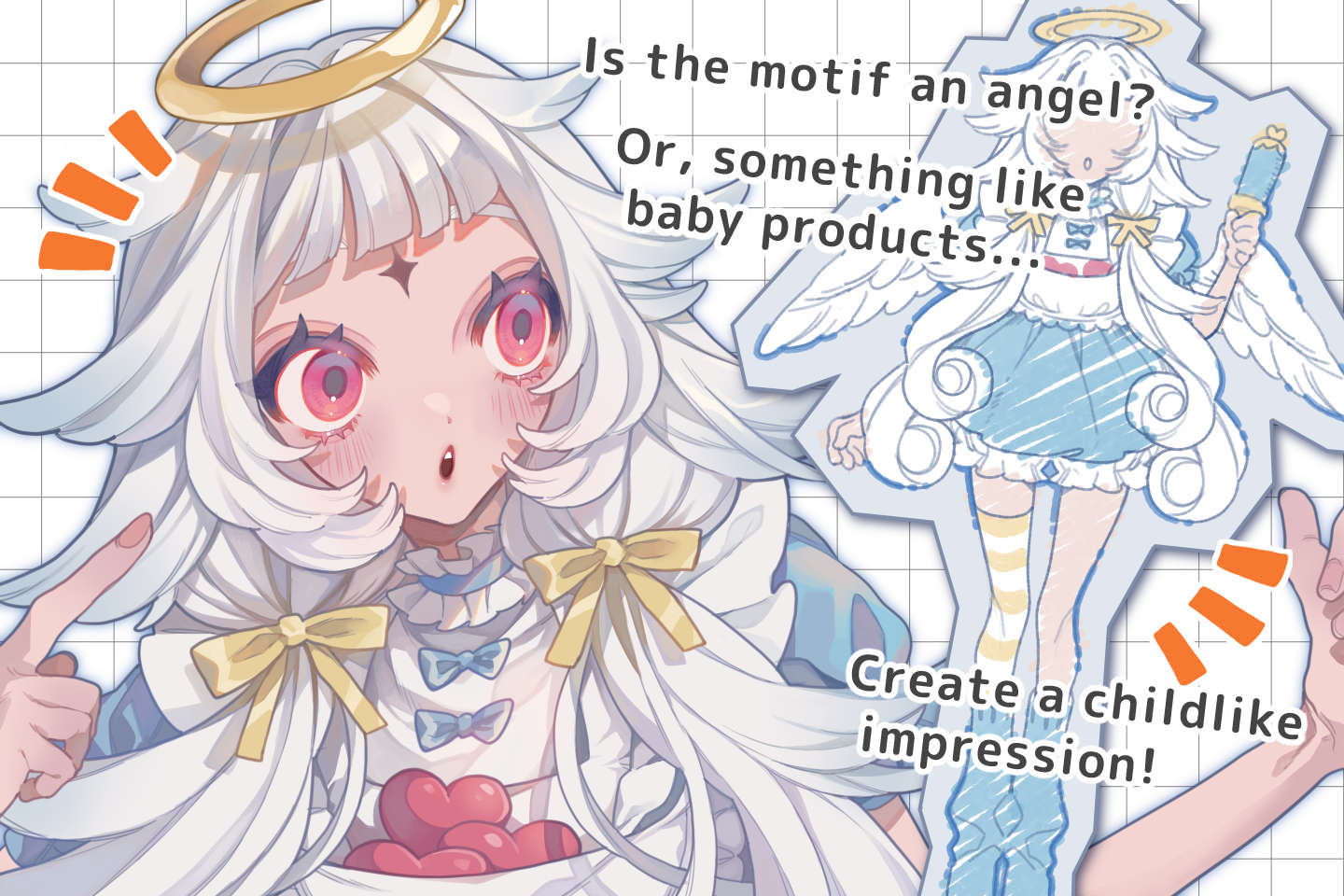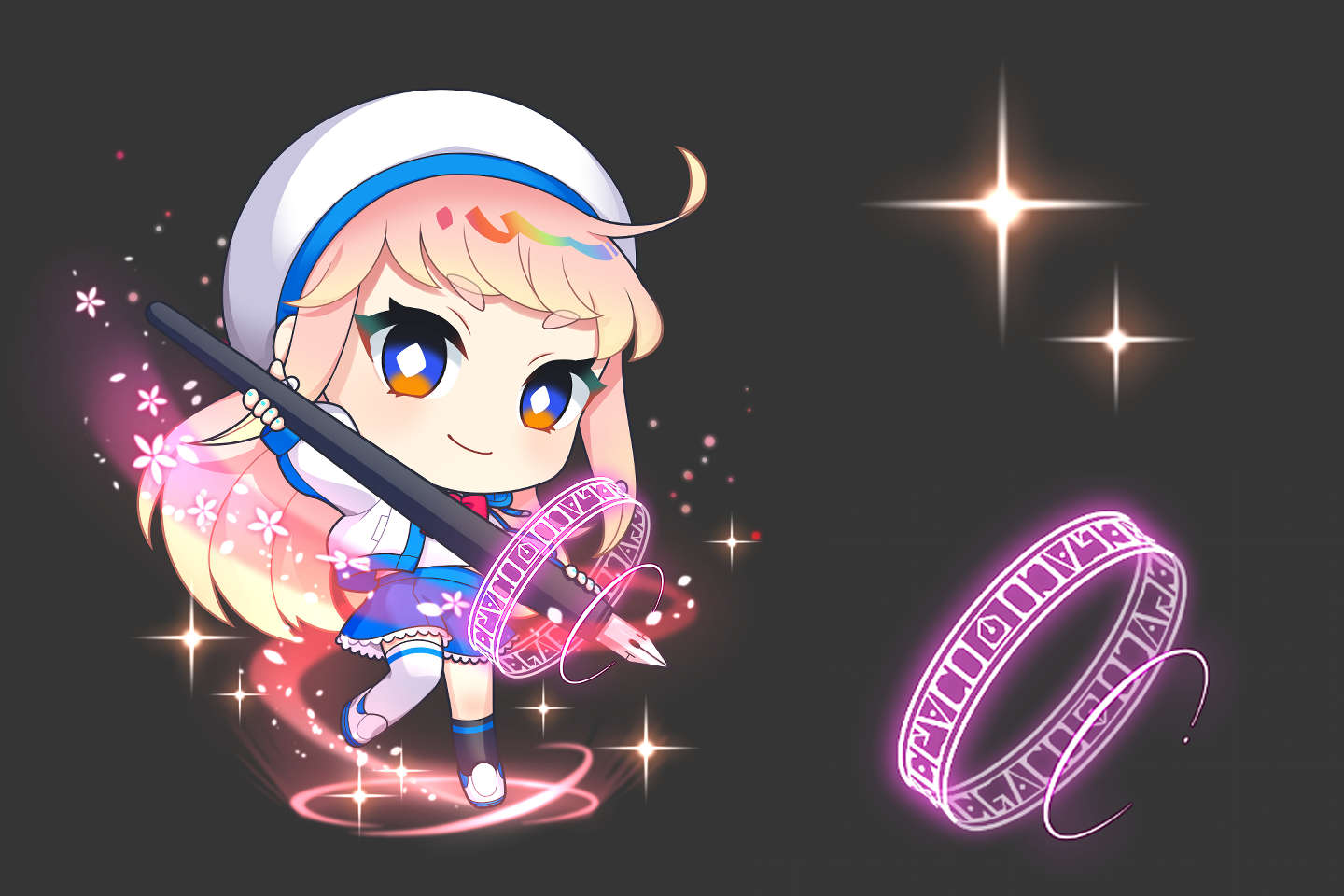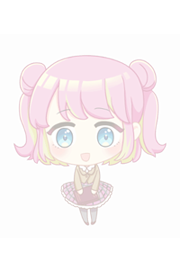
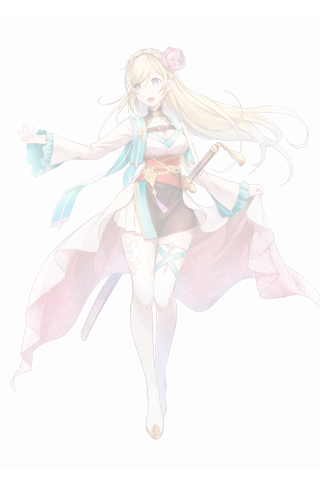

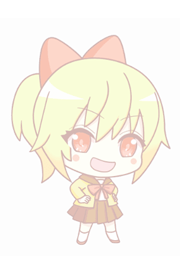
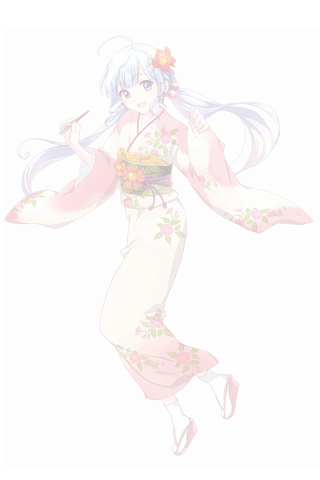
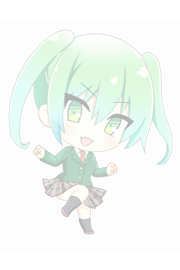







This article was created by the illustrators and manga artists who teach at the illustration and manga school, egaco, based on the knowledge and skills they have honed through commercial production and other work. If you would like to learn more about content that is tailored to what you want to draw, we recommend taking a private lesson at egaco.
Here, we will explain from drawing procedures of four-panel comics (i.e., manga) to how to present your four-panel comics to others including how to come up with ideas for the story .
If you are having trouble figuring out how to draw a four-panel comics or how to come up with ideas for the story, please refer to this article.
Recommended for comic beginners, too! Features of four-panel comics
What is four-panel comics, anyway?

Four-panel comic is a type of short comics that is made up of four panels.
Panels are all the same shape, and this is a comic format that is used to tell a minimum story.
Merit of drawing four-panel comics
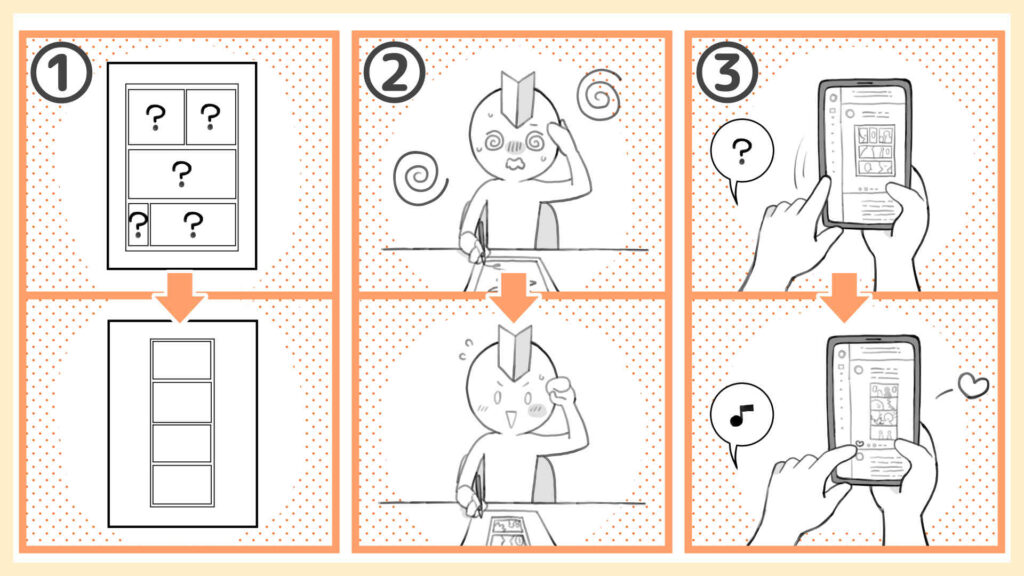
There are three advantages of drawing four-panel comics:
- Because the panels in four-panel comics are all the same shape, you don’t have to worry about panel layout, unlike with general comics.
2. They are easy for beginners who want to draw comics to get started with.
3. Even for people who don’t usually read comics, they are easy to read and familiar.
First of all, the panels of a four-panel comic are all the same shape, so you don’t have to worry about panel layout, unlike with a regular comic.
Furthermore, because four-panel comics are short stories, they are easy for beginners who want to draw comics to get started with, and even for people who don’t usually read comics, they are easy to read and familiar. This is four-panel comics advantage.
Procedures of creating four-panel comics
We will explain drawing procedures of four-panel comics in a simple way for beginners
STEP 1: Decide the title
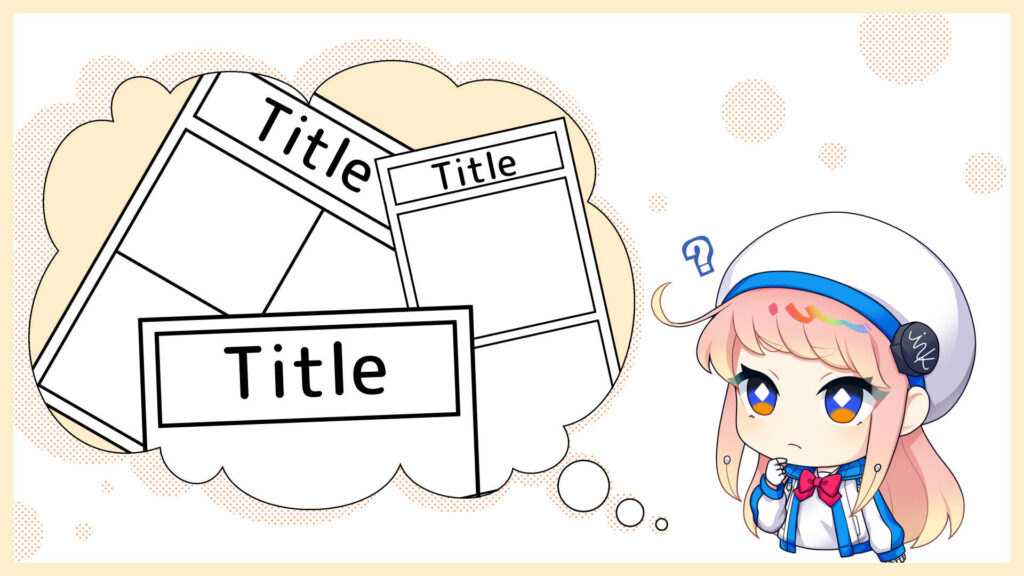
First, let’s decide on the title for the four-panel comic.
If you decide on the title first, the title of the four-panel comic will also become the theme of the work, so it will be less likely for the story to stray from the theme.
STEP 2: Let’s write panel frame lines
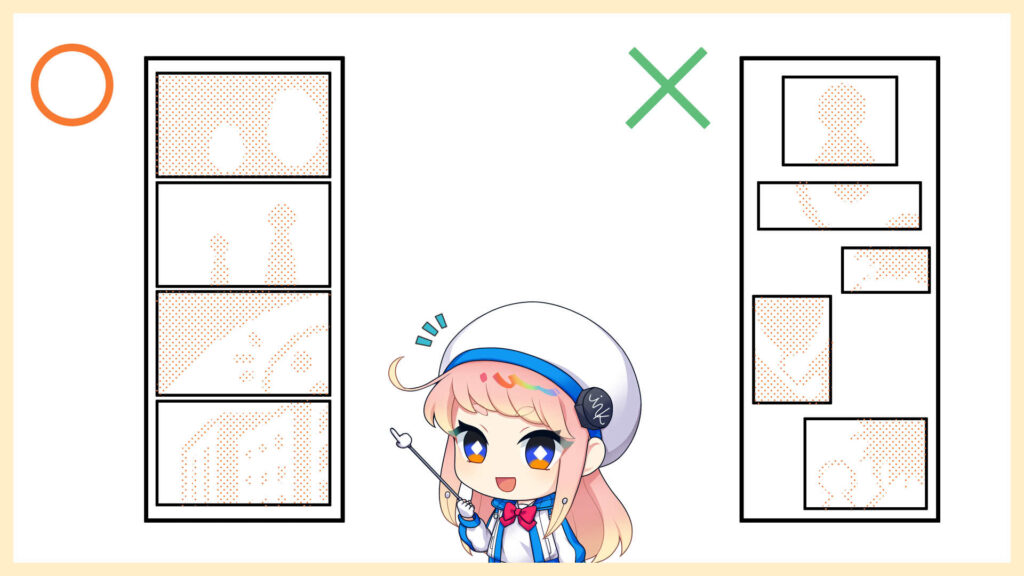
Next, draw the panel lines.
In a four-panel comics, all the panels are the same shape and are lined up evenly.
STEP 3: Let’s think about the story
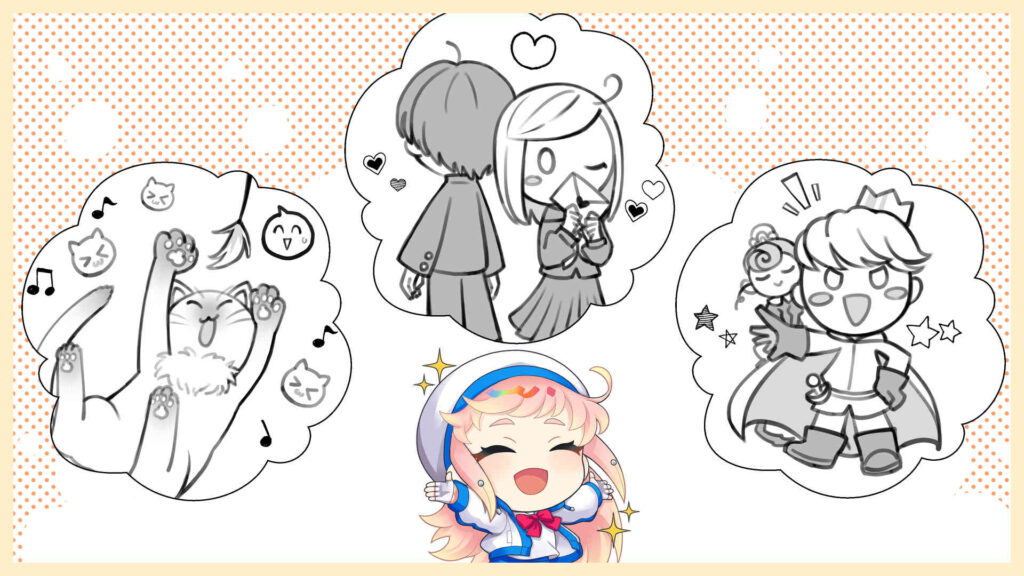
The story is an important part of the process of drawing a four-panel comic.
It is easier if you think about the story based upon the introduction, development, transition and conclusion.
What is Japanese kishotenketsu, i.e., introduction, development, transition and conclusion of the story?
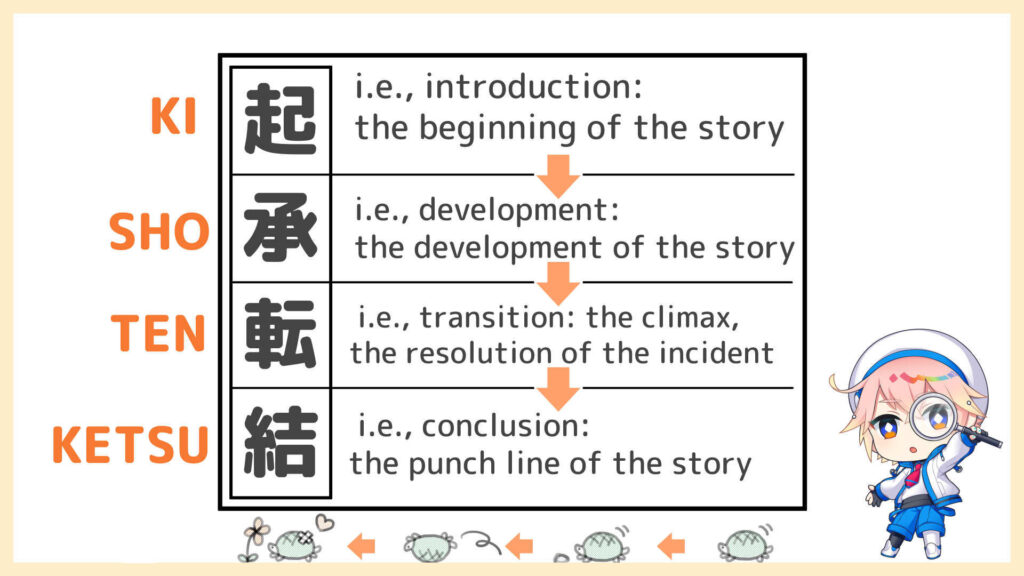
The kishotenketsu is a framework for clearly conveying the story and its structure to the reader.
● Ki, i.e., introduction: the beginning of the story, introduction of the setting
● Sho, i.e., development: the occurrence of an incident, the development of the story
● Ten, i.e., transition: the climax, the resolution of the incident
● Ketsu, i.e., conclusion: what happens after the story, the punch line of the story
If you want to know more about Japanese kishotenketsu, we also recommend this article.
Tips for coming up with ideas for four-panel comics
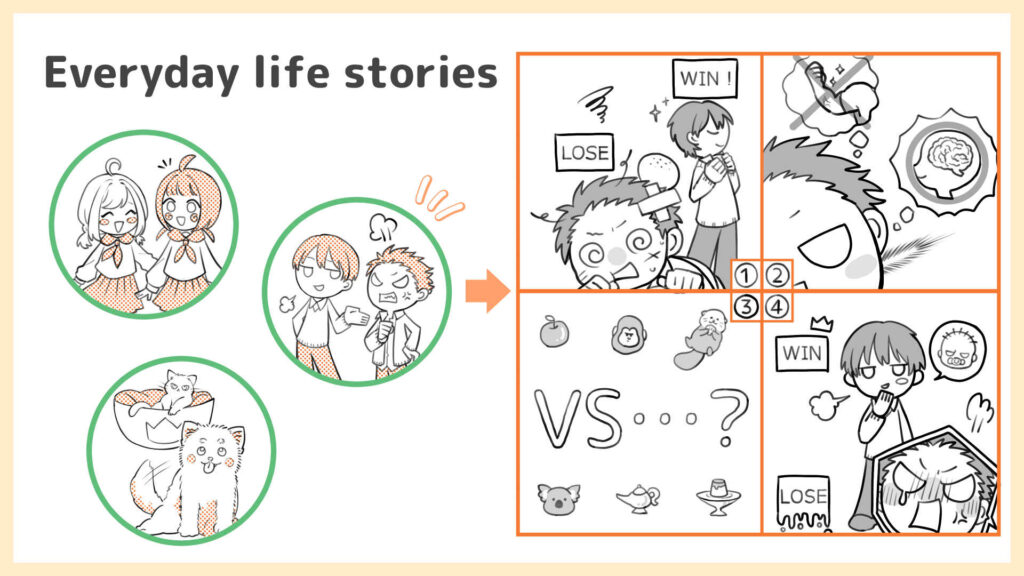
Everyday life is a good source of materials for four-panel comics, and it’s also a subject that is easy to get sympathy from others.
The advantage is that it’s not that difficult to think of stories because they are things that are familiar to us.
For example, you could use things that happen in everyday life as the story of your comics such as stories about friendships, sibling quarrels, or pets.
It’s recommended that you choose a theme and then think of stories related to that theme, and delve deeper into them to come up with stories easily for four-panel comics.
Example: Sibling quarrel -> The younger brother always loses -> How do you win? -> Let’s play a game of shiritori! -> He loses again… etc.
Note: Shiritori is a Japanese game of taking the last syllable of a word given by someone else and saying a ward that begins with that syllable; make word chains.
Step 4: Let’s put the story you have come up with into a four-panel comic
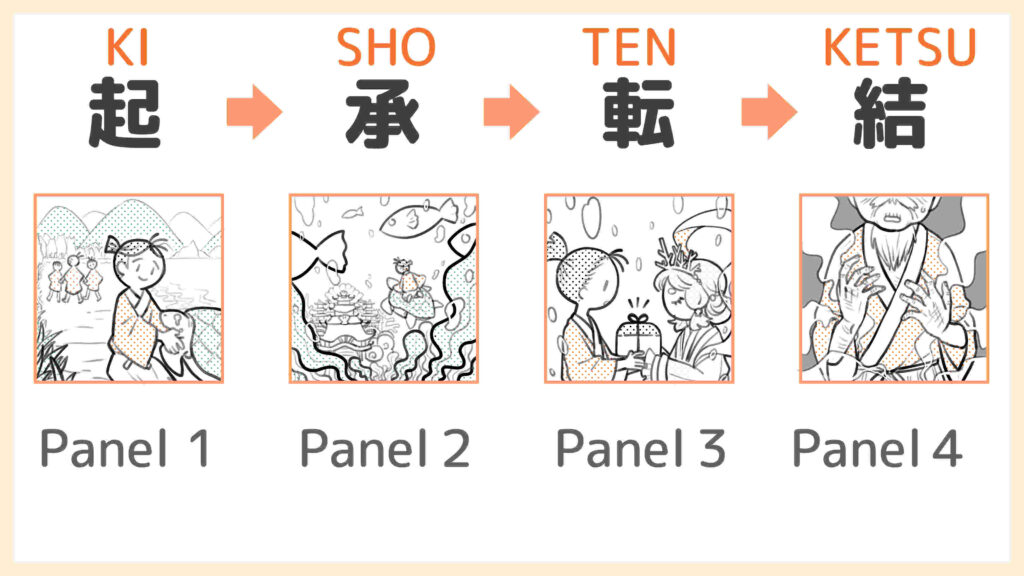
起….Ki of kishotenketsu, i.e., introduction
承…Shou of kishotenketsu, i.e., development
転…Ten of kishotenketsu, i.e., transition
結….Ketsu of kishotenketsu, i.e., conclusion
Once you’ve come up with a story, the next step is to turn it into a four-panel comic.
To use the story of Urashima Taro (a Japanese once-upon-a-time story) as an example,
● Panel 1: Urashima Taro rescues the turtle. (Opening)
● Panel 2: The turtle invites Urashima Taro to the Dragon Palace to thank you for his help. (Development)
● Panel 3: He spends a few days at the Dragon Palace, but decides to return to land. At that time, he receives the treasure box. (Transition)
● Panel 4: When he returns to land, several hundred years have already passed. When he opens the treasure box, he turns into an old man. (Conclusion)
If you add a punch line along the lines of kishotenketsu, i.e., the four stages of the story, it will become a true four-panel comic.
However, if you include too much information, it won’t fit into a four-panel comic, so you’ll need to make some choices.
STEP 5: Draw the pictures, speech bubbles and handwritten text
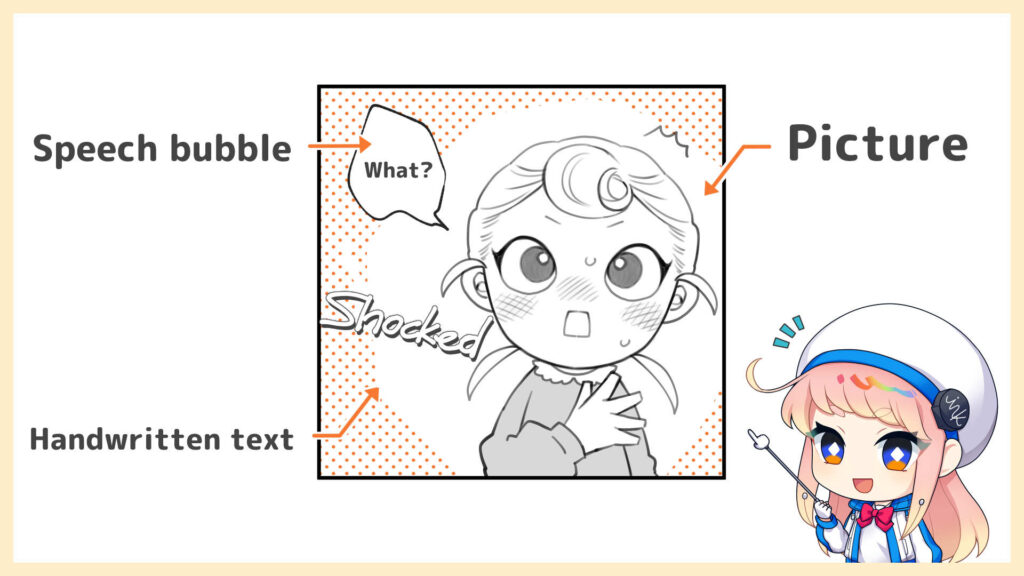
Let’s draw pictures, speech bubbles and handwritten text.
Because the size of the panels in a four-panel comic is fixed, be careful when placing the speech bubbles so that they don’t fill up the whole panel.
If you want to know more about drawing text, we also recommend this article.
漫画の魅力を上げる描き文字の基本と6つのコツ(描き文字使い分け)….The basics of drawing handwritten text to enhance the appeal of comics and six tips (using different types of handwritten text)
If you want lots of people to see the four-panel comic you’ve drawn
Once you’ve finished your four-panel comic, why not submit it to a social networking site or a competition so that lots of people can read it.
Let’s post your four-panel comics on social networking sites
Four-panel comics are often posted on social networking sites such as X (formerly Twitter), Instagram, and pixiv.
On X, there are lots of hashtags for people who draw comics and people who want to read them, such as #Hushtag which you can read comics.
Instagram and pixiv also use hashtags, and it is common to add many tags to make it easier to be searched.
Let’s make use of these SNS and get as many people as possible to see your work.
What kind of four-panel comic is likely to be well-received on SNS?
As you might expect, everyday life-based material is a popular topic on SNS.
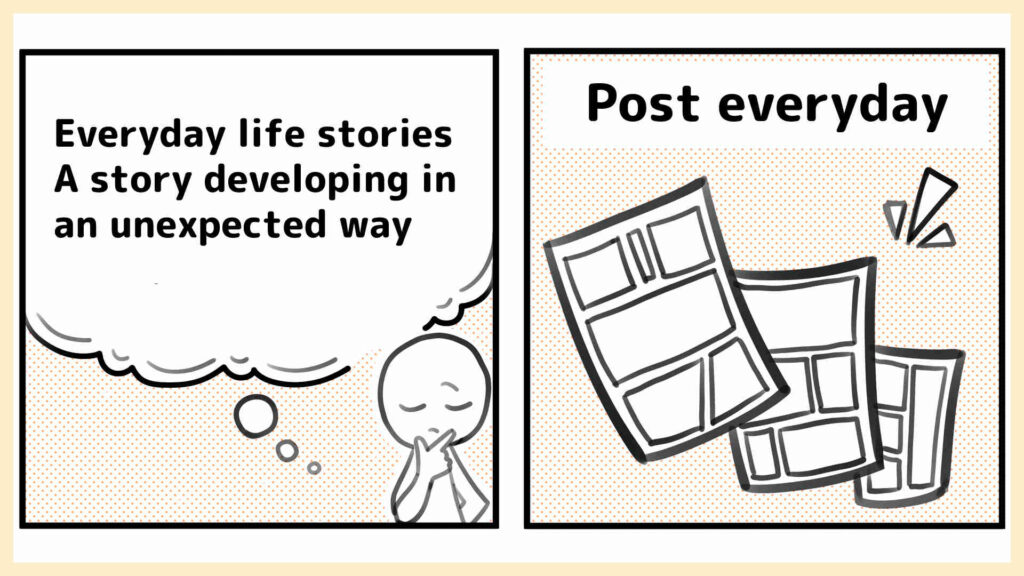
Materials that readers can easily sympathize are likely to be well-received, and it is also a good idea to aim for a gap such that readers were expecting everyday life story, but actually the story turned out to be a fantasy.
On SNS, the more frequently you update your content, the more likely it is to be seen by users and become a topic of conversation, so try to update your content as often as possible within the range you don’t feel it hard.
Points to keep in mind when posting four-panel comics on SNS
There are four points that you have to be careful when posting four-panel comics on SNS.
- Do not violate public order and morals
- Check the terms and conditions of each SNS
- Do not post anything you have drawn by tracing or copying other’s work
- It is a taboo to post something that is not your own work as your own work
Be sure to keep these four points in mind.
Since SNS is used by a large number of people, it is necessary to use it with common sense at all times.
Let’s enter your four-panel comic in a competition!
By entering your four-panel manga in a competition, you will have the chance to have your work seen by a wider audience.
Nowadays, there are also simple ways to enter competitions, such as by posting your work on social networking sites hosted by publishers using a hashtag.
Enter your work in a competition and get advice on your four-panel comic from professional editors!
Conclusion
The rules for four-panel comics are more flexible than for regular comics, and it is a form of comics which is very profound.
For gag comics, the basic rule is to follow the structure of kishotenketsu, i.e., introduction, development, transition and conclusion, and then add a punchline; however, there are also many works in other genres such as romantic comedy, gourmet, and everyday life that are not bound by this structure.
Let’s draw four-panel comics that match the genre you want to draw, and show them to lots of people.
